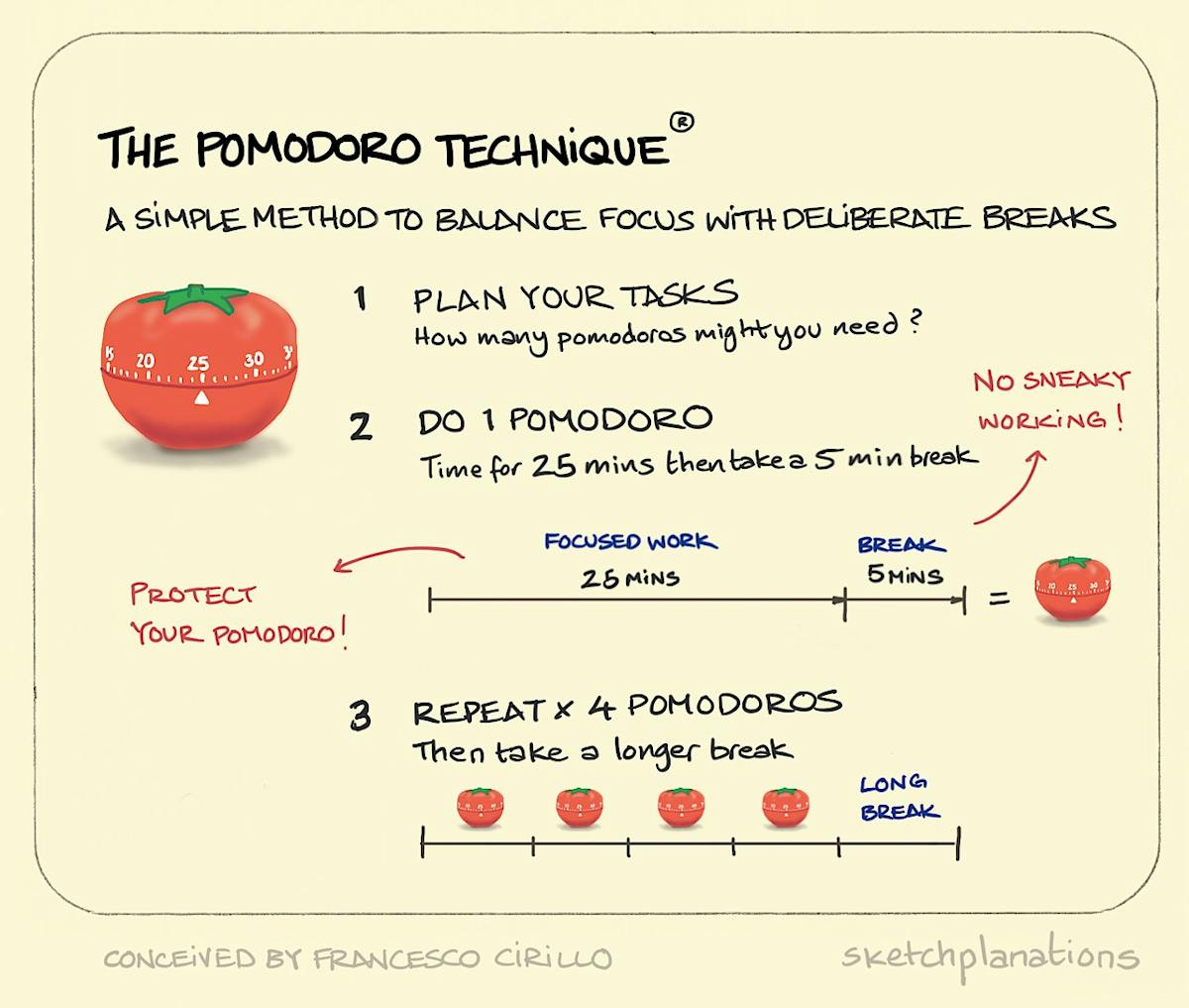Introduction
In today’s fast-paced world, distractions are everywhere. From social media notifications to email alerts, maintaining focus on tasks can be challenging. The Pomodoro Technique, developed by Francesco Cirillo in the late 1980s, is a time management method that helps individuals improve focus, productivity, and efficiency.

By using structured time intervals—typically 25 minutes of work followed by a short break—this technique aims to optimize mental energy and enhance productivity.
Read More- Breaking Bad Habits
The Origin and Concept of the Pomodoro Technique
The Pomodoro Technique was named after the Italian word for “tomato,” inspired by the tomato-shaped kitchen timer Cirillo used as a university student. The technique follows a simple structure-
- Choose a task to work on.
- Set a timer for 25 minutes (one Pomodoro session).
- Work on the task until the timer rings.
- Take a short 5-minute break.
- Repeat the process four times, then take a longer 15–30 minute break.
This cycle promotes sustained concentration and prevents burnout, making it a powerful tool for students, professionals, and creatives alike.

Psychological Principles Behind the Pomodoro Technique
The psychological principles behind the pomodoro technique include-

1. Time Chunking and the Brain’s Attention Span
Research suggests that the human brain can maintain deep focus for a limited time before mental fatigue sets in (Boisvert & Shinyashiki, 2019). The Pomodoro Technique’s structured intervals align with studies indicating that people can focus optimally for around 20–30 minutes at a time before needing a break (Klingberg, 2009).
2. The Role of Breaks in Cognitive Function
Short breaks between Pomodoro sessions help prevent mental fatigue and improve information retention. Studies show that brief diversions can enhance performance by refreshing cognitive resources (Ariga & Lleras, 2011). This aligns with the Pomodoro Technique’s built-in breaks, which allow the brain to reset and maintain high levels of productivity.
3. Reduction of Procrastination and Anxiety
The Pomodoro Technique helps overcome procrastination by breaking tasks into manageable time slots, reducing feelings of being overwhelmed (Steel, 2007). By setting a small, achievable goal—just 25 minutes of focused work—individuals are more likely to start and continue working on tasks.
4. The Zeigarnik Effect and Task Completion
The Zeigarnik Effect, a psychological phenomenon where incomplete tasks remain in memory longer than completed ones, supports the Pomodoro Technique (Zeigarnik, 1927). By breaking work into Pomodoro sessions, individuals maintain task momentum and experience a greater sense of accomplishment.
Benefits of the Pomodoro Technique
Some benefit of pomodoro technique include-
- Enhanced Productivity- By working in focused bursts, individuals maximize their efficiency while minimizing wasted time. Studies on time management suggest that structured work intervals improve overall performance (Baumeister & Tierney, 2011).
- Improved Focus and Concentration- Eliminating multitasking and dedicating 25-minute sessions to a single task improves concentration. Research shows that multitasking reduces productivity and cognitive performance (Rosen, 2008), making focused work sessions more effective.
- Better Work-Life Balance- Taking scheduled breaks prevents burnout and promotes mental well-being. The Pomodoro Technique ensures regular downtime, reducing stress levels and enhancing overall work-life balance.
- Increased Motivation- Short, attainable goals create a sense of achievement, keeping individuals motivated. Gamifying work through time management techniques like Pomodoro has been shown to boost engagement and drive (Deci & Ryan, 1985).
- Enhanced Learning and Retention- For students, the Pomodoro Technique aligns with cognitive science principles, helping with memory retention and deep learning. Regular breaks aid in consolidating new information into long-term memory (Pashler et al., 2007).
Challenges and Criticisms of the Pomodoro Technique
Some of the challanges and criticism to this technique include-
- Rigidity and Interruptions- Some critics argue that the strict 25-minute work intervals may not be suitable for all tasks. Creative work or complex problem-solving may require longer deep-focus periods (Csikszentmihalyi, 1990).
- Not Ideal for Collaborative Work- Pomodoro sessions are most effective for individual tasks. In team settings, the need for flexibility and spontaneous discussions can make adherence to timed intervals challenging (Gifford, 2019).
- Potential for Stress in Time-Limited Work- For some individuals, the ticking timer may create anxiety rather than motivation, especially when facing tasks requiring extended periods of deep thought (Eysenck & Calvo, 1992).
Adapting the Pomodoro Technique for Different Needs
Pomodore technique can be adapted to different needs, like-
- The 52/17 Rule- An alternative to the traditional Pomodoro, research suggests that working for 52 minutes followed by a 17-minute break may yield optimal productivity (DeskTime, 2014).
- Flow State Considerations- Those engaging in deep creative work can modify the Pomodoro structure by extending focus periods when experiencing a flow state (Csikszentmihalyi, 1990).
- Custom Break Activities- Instead of passive social media scrolling, effective break activities include stretching, meditation, or short walks to enhance cognitive recovery (Oppezzo & Schwartz, 2014).
Conclusion
The Pomodoro Technique remains one of the most popular time management strategies, helping individuals boost focus, enhance productivity, and maintain mental well-being. By breaking work into structured intervals, the technique leverages cognitive science principles to optimize efficiency and reduce procrastination. While it may not be universally applicable, those who adapt the method to their workflow can experience significant improvements in their time management and work habits.
References
Ariga, A., & Lleras, A. (2011). Brief and rare mental “breaks” keep you focused: Deactivation and reactivation of task goals preempt vigilance decrements. Cognition, 118(3), 439-443.
Baumeister, R. F., & Tierney, J. (2011). Willpower: Rediscovering the Greatest Human Strength. Penguin.
Boisvert, J., & Shinyashiki, B. (2019). Understanding attention span limitations in cognitive performance. Journal of Cognitive Enhancement, 3(2), 95-110.
Csikszentmihalyi, M. (1990). Flow: The Psychology of Optimal Experience. Harper & Row.
Deci, E. L., & Ryan, R. M. (1985). Intrinsic Motivation and Self-Determination in Human Behavior. Springer Science & Business Media.
Klingberg, T. (2009). The Overflowing Brain: Information Overload and the Limits of Working Memory. Oxford University Press.
Steel, P. (2007). The nature of procrastination: A meta-analytic and theoretical review of quintessential self-regulatory failure. Psychological Bulletin, 133(1), 65-94.
Zeigarnik, B. (1927). On finished and unfinished tasks. Psychologische Forschung, 9, 1-85.
Subscribe to PsychUniverse
Get the latest updates and insights.
Join 3,022 other subscribers!
Niwlikar, B. A. (2025, February 10). 4 Interesting Mind Hacks That Make the Pomodoro Technique Work. PsychUniverse. https://psychuniverse.com/pomodoro-technique/




Pingback: Brain Fog: What It Is, 5 Important Reasons Why It Happens, and How to Clear It - PsychUniverse